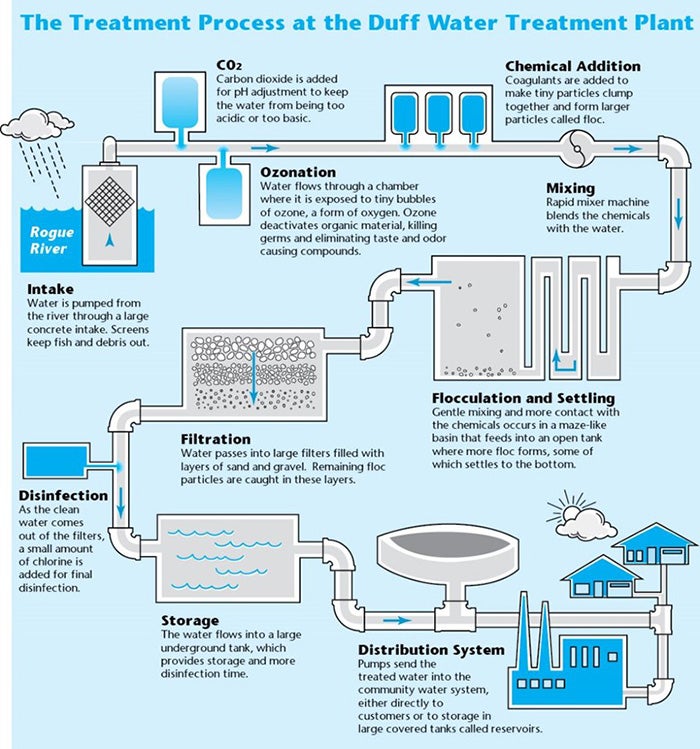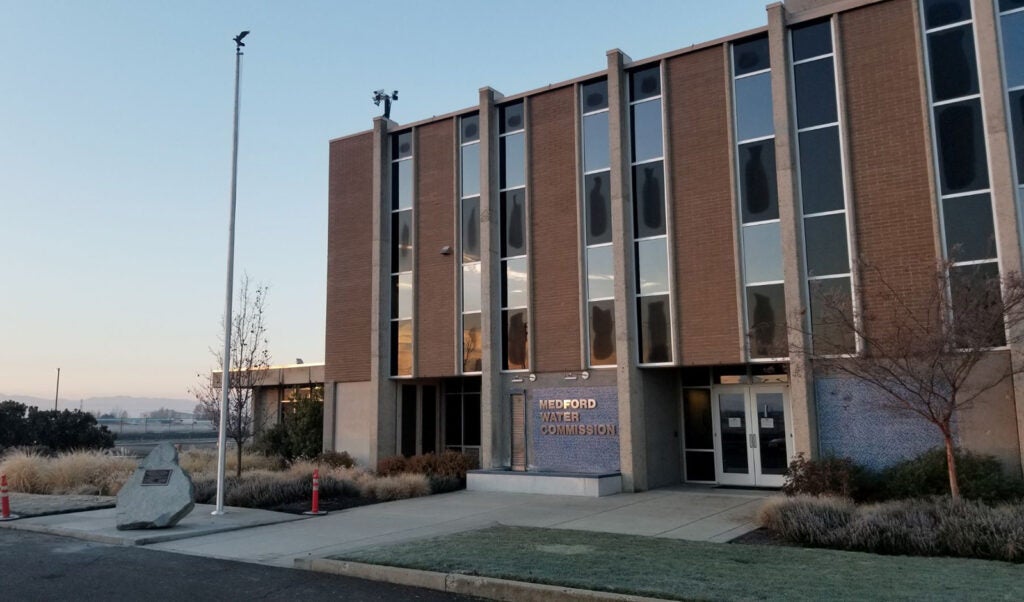While our water sources are both of excellent quality, both receive at least a minimal level of treatment as required by the Environmental Protection Agency (EPA) to protect its high quality all the way to your tap. Our water is effectively disinfected with much less treatment than limits allow.
Our Two Sources and How They Are Treated
We have two sources of water: Big Butte Springs and the Rogue River. The springs, located near Butte Falls, are an exceptionally high-quality groundwater source that require no filtration or treatment other than disinfection per Environmental Protection Agency (EPA) drinking water standards, to ensure it remains high quality throughout our distribution system and all the way to your home. This is accomplished with on-site chlorination at a state-of the-art treatment facility; spring flows are collected underground and never see the light of day until emerging from customers’ taps.
The Rogue River, used only during peak-demand months (generally throughout the summer), is also considered high-quality, but as a surface water source is subject to a much more extensive treatment process to meet drinking water standards. It receives full conventional treatment at the A. Duff Water Treatment Plant, which consists of coagulation, settling, and filtration, followed by disinfection. In addition, the water treatment process involves adding carbon dioxide (CO2) to adjust the pH level and exposing the water to ozone (O3), a form of oxygen, that helps kill germs and eliminate taste and odors. The intake facility is located on the Rogue River and consists of a concrete structure on the edge of the river that houses screens and pumping units.
See a diagram of the full treatment process below.

When both sources are used, the water is blended within the distribution system, although some areas receive more water from one source or the other. The finished water from both supplies is very similar, with temperature being the most detectable difference. The blend can vary continuously depending on the demand for treated water from the treatment plant.
If Our Water Sources Are of Such High Quality, Why Do They Need to Be Disinfected?
Drinking water must be disinfected to treat disease-causing microbial pathogens (e.g., bacteria, viruses, protozoa, parasites). Chlorine, in the form of sodium hypochlorite, is used as a disinfectant in our treatment process; we are required to maintain a residual amount in the water to provide continuous protection from microbial contamination as it travels through our distribution system to your tap. Sampling throughout the system confirms that the amount of chlorine present is neither too low nor too high per the limits set by the EPA. Our water is effectively disinfected with much less chlorine than the allowable limit.
More on the Robert A. Duff Water Treatment Plant
The Robert A. Duff Water Treatment Plant is where our supplemental drinking water source, the Rogue River, receives full conventional treatment. The plant, intakes, and transmission main to town were constructed in 1967 and 1968, with an original treatment capacity of 15 MGD (million gallons per day). The plant and river intake were expanded to 30 MGD in 1983, and in 1997, improvements were made to help ensure efficient operation of the plant under wintertime conditions if needed. Design and construction involving structural, mechanical, electrical, and instrumentation and control upgrades were undertaken during the 1998-99 fiscal period. Phase III filter expansion was completed in 2000, which increased the water treatment capacity to 45 MGD, ozonation facilities were added in 2002, and in 2010, intake screens were installed to meet updated fish screening requirements. Current permits allow the use of up to 65 MGD (100 cubic feet per second) of natural stream flow water rights out of the Rogue River, and a long term, multi-faceted project is currently underway that will eventually expand the treatment capacity of the plant to 65 MGD, as well as complete conveyance improvements necessary to deliver the 65 MGD into our system.

The plant is named after engineer Robert A. Duff, hired in 1925 and instrumental in the design and construction of not only both of Medford Water’s supply pipelines from Big Butte Springs to town— finally giving Medford residents a high-quality water supply—but in other facilities as well, such as numerous water reservoirs. He eventually served as manager from 1931 to 1952, before becoming City Superintendent and then City Manager of Medford in 1954. The plant is part of the Robert L. Lee Water Quality Complex, located on the river near TouVelle State Park. Hired as an Assistant Engineer in 1947, Robert (“Bob”) Lee also played an enormous role in the development of the high-quality water supplies that support Medford and its surrounding communities today. He oversaw the construction of the second Big Butte Springs pipeline and Willow Creek Dam, and was instrumental in filing for water rights on the Rogue River and construction of initial phases of the treatment plant, later serving as manager from 1954 to 1982.
Under the guidance of both Duff and Lee, Medford Water developed the high-quality water supplies that support Medford and surrounding communities today, and their vision serves as an inspiration as we plan for the future.